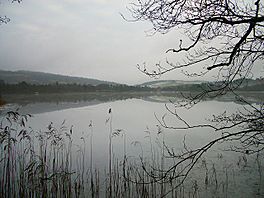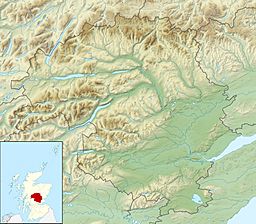Loch of Craiglush facts for kids
Quick facts for kids Loch of Craiglush |
|
|---|---|

Loch of Craiglush in the winter
|
|
| Location | NO043443 |
| Coordinates | 56°34′52″N 3°33′31″W / 56.581°N 3.5587°W |
| Type | freshwater loch |
| Primary inflows | Lunan Burn |
| Primary outflows | Lunan Burn |
| Catchment area | 14.9 km2 (3,680 acres) |
| Max. length | 310 m (1,020 ft) |
| Max. width | 201 m (659 ft) |
| Surface area | 26.3 ha (65 acres) |
| Average depth | 4.9 m (16 ft) |
| Max. depth | 13 m (44 ft) |
| Water volume | 138,980 m3 (4,907,900 cu ft) |
| Shore length1 | 2.3 km (1.4 mi) |
| Surface elevation | 103 m (338 ft) |
| Max. temperature | 16.2 °C (61.2 °F) |
| Min. temperature | 9.4 °C (49.0 °F) |
| Islands | 1 |
| 1 Shore length is not a well-defined measure. | |
The Loch of Craiglush is a beautiful freshwater loch, which is the Scottish word for lake. It's found about 1.5 miles (2.4 km) north-east of a town called Dunkeld in Perth and Kinross, Scotland.
This loch is very important for nature. It's officially known as a Site of Special Scientific Interest (SSSI). This means it has special plants, animals, or geology that need protecting. It's also part of a larger Special Area of Conservation, which helps protect habitats across Europe.
Fishing Fun at the Loch
Loch of Craiglush is one of several lochs in this area that are all connected. These lochs include Loch of the Lowes, Loch of Butterstone, Loch of Clunie, Loch of Drumellie, Loch Rae, Fingask Loch, Loch White, Loch Black, and the Stormont Loch.
All these lochs eventually drain into the Lunan Burn. This burn then flows into the River Isla, which later joins the mighty River Tay.
If you enjoy fishing, you'll find different types of fish in these waters. Many of these lochs are home to pike and perch. In Loch of Craiglush, along with Loch of the Lowes and Loch of Butterstone, you can also catch trout. It's a great spot for a fishing adventure!


